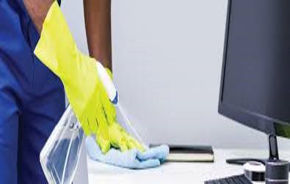Credit: KOTOIMAGES / Shutterstock.com
Our homes are supposed to be safe havens, but there are a number of ways your house might be negatively impacting your health. Indoor air quality—which can sometimes be significantly worse than outdoor air—or the water coming into your home can sometimes be vectors for things that make us feel ill, or that can cause illness over the long term. And many of these things are subtle and difficult to detect—if not literally invisible.
It can be challenging to figure out whether something in your house is a potential threat to your short- or long-term health. If you think something in your house is making you feel sick you should always consult with a doctor or healthcare professional before jumping to conclusions about potential causes. But while doing that, it’s worth investigating the things in your house that could be making you sick—just keep in mind that just because you find something on this list doesn’t necessarily mean it’s what’s causing you to feel ill.
Mold
Mold spores can cause a range of symptoms from sneezing and congestion to coughing and wheezing. Even if you don’t smell mold, inspecting your house for evidence of mold is never a bad idea. The Centers for Disease Control (CDC) doesn’t recommend home mold testing—if you see evidence of mold, it doesn’t really matter what kind it is, it needs to be cleaned up.
Dust and allergens
Make sure all fabrics (like carpets and curtains) are clean and thoroughly vacuumed to remove dust and other airborne pollutants. We have a guide here showing what to do to keep indoor allergens under control.
Surface germs
Wipe down surfaces that get touched a lot, like light switches and doorknobs, which might be transferring bacteria to you that’s making you sick. And look for signs of insects in your house: Bugs like roaches can spread bacteria around your house that could be making you sick.
Carbon monoxide (CO)
Carbon monoxide is a dangerous gas that can cause fatigue, headaches, and many other symptoms. At high concentrations it can be fatal without you noticing, so you should always treat CO in your home as an emergency situation. Carbon monoxide can come from sources like your gas-powered water heater or furnace. The CO in their exhaust should be carried out of the house via your chimney, but if you have a leak somewhere or if your chimney is in disrepair or blocked (you’ve inspected it recently, haven’t you?) those gases can build up in the air—and make you sick, or worse. If you don’t already have CO alarms, install some immediately. If you do, make sure they’re working correctly and don’t need to be replaced.
Carbon dioxide (CO2)
At normal levels, CO2 isn’t dangerous—in fact, our own bodies produce it. At high concentrations, however, it can cause a long list of negative symptoms and, in extreme cases, even lead to death. It’s a good idea to monitor your home’s air quality and keep track of CO2 levels. If you discover that these levels are higher than they should be, have an HVAC professional inspect your water heater and heating systems, and check that your chimney is clear and working as expected.
Water contaminants
The United States has some pretty good drinking water, all things considered, but both well water and city water can be contaminated with a variety of things that can make you sick on a regular basis.
-
Bacterial contamination in well water: Well water can be contaminated by a variety of pollutants, including coliform bacteria, some of which can cause you to feel ill. You should regularly test your well water, and if you find bacteria, you can try “shocking” it with chlorine.
-
Lead: Lead gets into our drinking water in a variety of ways, and it can be very dangerous—the EPA’s safe exposure level is zero—if you’re exposed to it over a long period of time. You can have your water tested for lead via a certified laboratory or an approved home test kit.
-
Nitrates and other chemicals: Several dangerous substances can find their way into both well and tap water, like nitrates (from fertilizer that washes into the water supply), arsenic, and so-called “forever chemicals.”
You can test your tap water pretty easily to see if it’s the cause of your symptoms. Filters—either at the tap, in a pitcher, or a whole-house system—can help, but most filters can’t remove bacteria or many chemicals (like nitrates) effectively, so you can’t necessarily just slap a Brita on the tap and call it a day. If you detect any of these pollutants in your water, you should contact your local authorities and call the Environmental Protection Agency.
Cigarette smoke residue
If previous residents smoked cigarettes indoors, you might be dealing with “thirdhand smoke.” The dangerous chemicals released in cigarette smoke stick to surfaces and sink into other areas of the house and can cause a wide range of symptoms. You can try getting rid of thirdhand smoke residue with a thorough cleaning and de-cluttering, but if the smoke is embedded in the bones of the house you might be facing a gut renovation to clear it out.
Drug lab residue
This one is rare, but it happens. A few years ago, a family in Tennessee couldn’t understand why they were all getting mysterious respiratory illnesses after moving into their new home. They discovered that the previous resident ran a meth lab out of the house—and the residual contamination from the illegal lab was making them all sick. Look for signs that your house might be contaminated by a previous drug lab. If you think you see them, your best bet is to hire a company to clean it up for you—but be prepared to pay a hefty fee for the service.
Offgassing from VOCs
Even a new (or newly-furnished) house can make you sick. Volatile Organic Compounds (VOCs) are chemical compounds that turn into vapor at room temperature—stuff like benzene or formaldehyde. These chemicals are found in a wide range of products, including paint, furniture, carpeting, curtains, and other household stuff. When new, these products “off-gas” VOCs for a period of time. Because you’re indoors, these VOCs get concentrated—up to ten times higher than in an outdoor area.
When you breathe in VOCs, you can have a wide range of symptoms, including headaches, eye and throat irritation, or nausea. Long-term exposure can make you seriously ill. If your house is new construction or if you’ve just had a renovation done—even if you’ve recently painted or had new furniture delivered—your sudden illnesses might be due to the VOC off-gassing. The good news is that it will fade over time, and increasing the ventilation in your home by opening windows can help reduce their impact.
Radon
Another gas that can make you seriously ill is radon, a radioactive gas that is completely invisible to humans—you could be breathing it right now and not know it. And you can breathe it for a long time and not know it. But long-term exposure to radon can cause cancer, as the radioactive stuff gets into your lungs, and by the time you notice symptoms (like a persistent cough or breathing difficulties that don’t have any other obvious explanation), it might be too late. Most home inspections conducted at home sales include radon testing, but if yours didn’t it’s a good idea to test your home for radon either by hiring a professional or using a store-bought test. If your house tests positive you can mitigate the situation, but you should evacuate until that work is done and your home tests negative—and consult with a healthcare professional in the mean time.











